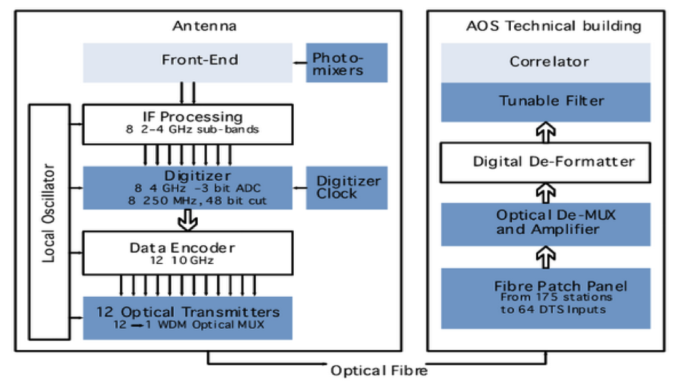Receivers
Front End
The ALMA Front End system is the first element in a complex chain of signal reception, conversion, processing and recording. It is designed to detect astronomical signals at ten different frequency bands. This system is far superior to any other in existence. In fact, products derived from ALMA prototypes are improving the sensitivities of other radio telescopes around the world. The Front End units are composed of numerous elements that are produced as far away as Europe, North America, Eastern Asia and Chile.
Cryostats: The largest individual element in the Front End system is the cryostat. With its three-stage cryo-refrigerator (110 K = -173°C, 15 K = -258 °C, 4 K = -269°C) it keeps the receivers at extremely cold temperatures. Operation at such low temperature greatly improves the sensitivity of the receivers and permits the use of superconducting materials.
Each cryostat can accommodate up to ten receivers, one per each ALMA frequency band. These are mounted on modular cartridges that can be installed or replaced with relative ease. The receivers are operated in the cryostat at an extremely low temperature, down to 4 Kelvin (or four degrees above the absolute zero, equivalent to -269 ºC) for bands 3 to 10 and 15 K for bands 1 and 2.
Frequency bands of receivers: The ALMA Front End, with all 10 receiver bands integrated, is able to detect signals from 8.6 mm to 0.32 mm in wavelength, equivalent to 35 GHz to 950 GHz in frequency. The following table shows the specifications of individual ALMA receivers for science observations (under commissioning):
| Band | Wavelength (mm) |
Frequency (GHz) |
| 1 | 8.57 - 6.00 | 035 - 050 |
| 2 | 4.48 - 2.59 | 067 - 116 |
| 3 | 3.57 - 2.59 | 084 - 116 |
| 4 | 2.40 - 1.84 | 125 - 163 |
| 5 | 1.84 - 1.42 | 163 - 211 |
| 6 | 1.42 - 1.09 | 211 - 275 |
| 7 | 1.09 - 0.80 | 275 - 373 |
| 8 | 0.78 - 0.60 | 385 - 500 |
| 9 | 0.50 - 0.42 | 602 - 720 |
| 10 | 0.38 - 0.32 | 787 - 950 |
During Cycle O and Cycle 1, science operation was only possible in four bands: Band 3, Band 6, Band 7, and Band 9. Three more bands were added during Cycle 2 and Cycle 3: Band 4, Band 8, and Band 10. Band 5 was added during Cycles 4 and 5. Band 1 has been in use since Cycle 10, and Band 2 is in development. It is expected to be available for science observations from Cycle 13.
The technical specifications of the different receivers are very demanding and at the time they were defined, they were cutting edge and beyond. In some cases, the performance of these receivers has gone beyond expectations.
The Front End integration centers: The construction of ALMA required consensus of the partners on several organizational and management decisions. This required several in-depth studies of different scenarios for assembling and integrating Front End components, and identified that the best solution was a “parallel approach,” integrating one Front End in Europe, another in North America and another in Taiwan, all with identical procedures. This was the preferred scenario due to logistical, organizational and programmatic considerations.
The European Front End Integration Center (FEIC) was located in England, at the Rutherford Appleton Laboratory, the North American one at the National Radio Astronomy Observatory (NRAO) of the USA and the East Asian one was at the Academia Sinica Institute of Astronomy and Astrophysics of Taiwan, all used for the integration of the Front End assemblies in operation in the ALMA antennas.
Water vapor radiometers (WVRs): Ground-based astronomical observations at millimetric and submillimetric wavelengths are strongly affected by the Earth's atmosphere, in particular by the presence of water vapor in the air. The effects are:
- Opacity: it makes the atmosphere less transparent. We use the WVR to measure the atmospheric opacity.
- Phase noise: it affects the coherence between signals from different antennas, with loss of sensitivity and a limitation to the longest useful baseline and to the highest useful frequency. This pose a limitation to the angular resolution that is achievable with a given configuration.
To be able to do interferometry, we need the WVR to correct the phase of the signals from each antenna, based on the local water vapor content, almost in real-time. The WVRs in operation at ALMA are a European delivery, designed and built by the Swedish company Omnisys Instruments.
Back End
ALMA's Back End systems convert analog signals -received by Front End units installed on each antenna- to digital signals and sends these to the Correlator installed in the Array Operations Site (AOS) Technical Building. This diagram shows signal processing and data transfer.

Diagram: ALMA signal processing and data transfer from the Front End to the Correlator.
The analog data, produced by Front End electronics, are processed and digitized before being entered into the data coder, followed by optic fiber transmitter units and multiplexers. These elements are all installed in each antenna's receiver booth. The optic signals are then transmitted by fiber to the AOS Technical Building where they are demultiplexed and de-formatted before entering the Correlator.
